Spears
Discover our wide selection of lances, ideal for historical fencing and medieval reenactments. Each lance is made from high-quality materials, ensuring strength and durability.
Perfect for both beginners and experts, our lances offer exceptional balance and an ergonomic design that makes them easy to handle. Explore the variety of styles and lengths available to find the lance that fits your needs and preferences.
The regatón is a fundamental accessory that is incorporated at the lower end of a spear, pole vault, cane, umbrella, or other similar objects. Its main purpose is to protect and stabilize the object, acting as a reinforcement at its base. This component, which can be seen as a plug or a stopper, is commonly made of iron or similarly sturdy materials, ensuring both its durability and functionality.
From a practical standpoint, the regatón serves several functions. On one hand, it protects the ground from damage by preventing direct blows that could arise from using or holding the object. On the other hand, it provides support on hard surfaces, which is very useful for maintaining the balance of the spear or cane in different situations.
But the regatón is not limited to utilitarian functions; it can also serve a decorative purpose. Many regatones are designed with an ornamental style aimed at enhancing the aesthetics of the spear or the object used, adding a more elegant or authentic touch and sometimes reflecting traditional craft techniques.
Furthermore, in personal defense contexts, the regatón can be used innovatively. Its shape and construction allow it to be employed as an improvised weapon in situations of aggression. In this sense, it can be a valuable tool if the need arises to defend oneself against an attacker, making it an additional resource for protection.
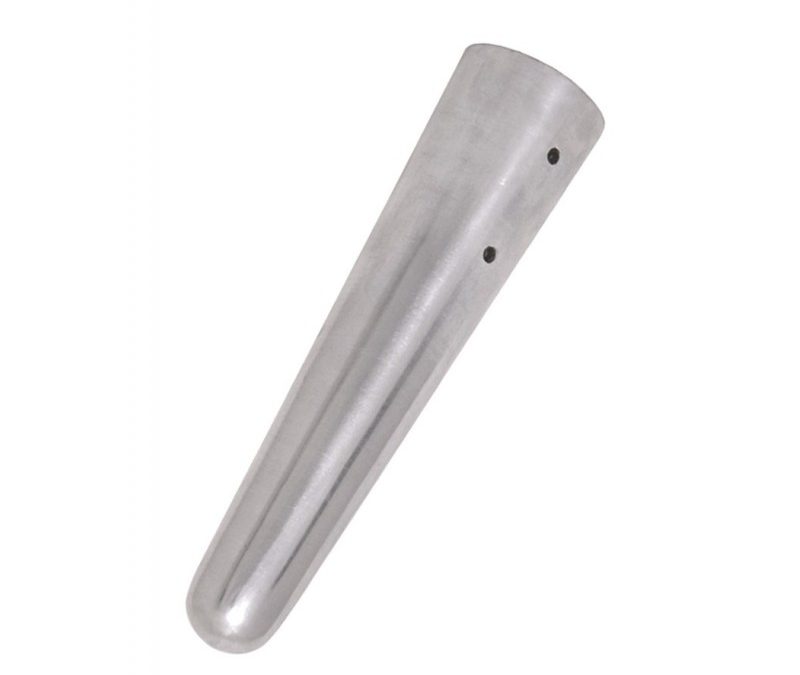
In conclusion, the regatón is a multifunctional element that goes beyond a simple addition to an object; it combines aesthetics, protection, and, at times, self-defense in a single component, making it an essential piece for those who use spears, canes, or similar implements.
Moharra is the term that designates the tip of the spear, a crucial element in the construction and functionality of this type of weapon. Commonly, the moharra is composed of two main parts: the blade, which is the sharp edge that allows for penetration and impact on the target, and the socket, the piece used to secure the blade to the shaft of the spear. This union is vital as it ensures the stability and resilience of the tip during its use in combat or exhibitions.
In the world of weaponry, the moharra is not only regarded as a part of the spear but can also have variations in its interpretation according to cultural traditions and historical periods. For example, in some cultures, the term may refer only to the blade, while in others it may encompass both components. This underscores the richness of language and its connection to the evolution of weapons over time.
The importance of the moharra lies in its role within the design and effectiveness of the spear as a tool for hunting, defense, and warfare. Its shape and material can significantly influence performance, being commonly made of bronze, steel, or other durable metals that allow for precise sharpening and a powerful impact.
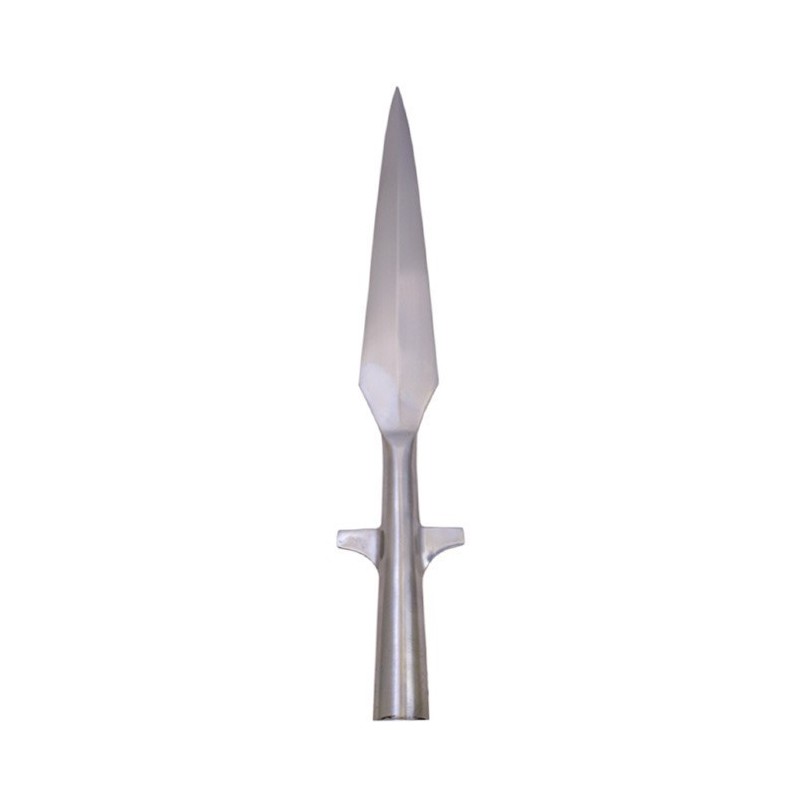
Today, the moharra remains of interest to collectors, historians, and enthusiasts of historical recreation. Its design and manufacture have evolved, and in the realm of e-commerce, it is possible to find historical reproductions and items related to historical fencing that pay homage to the rich tradition of these weapons.
It is essential to remember that when acquiring weapons or reproductions of weapons, one should consider the legal aspects that regulate their possession and use according to the current legislation in each country. Make sure to be informed about local regulations regarding the purchase and possession of such items to avoid legal issues.
The shaft of a spear is the fundamental component that makes up the main body of the weapon. Typically made of wood, although it can also be manufactured from metal, the shaft is essential for providing the necessary range and power for both throwing and direct combat. Among the most traditional woods used are ash and pine, both known for their strength and lightness.
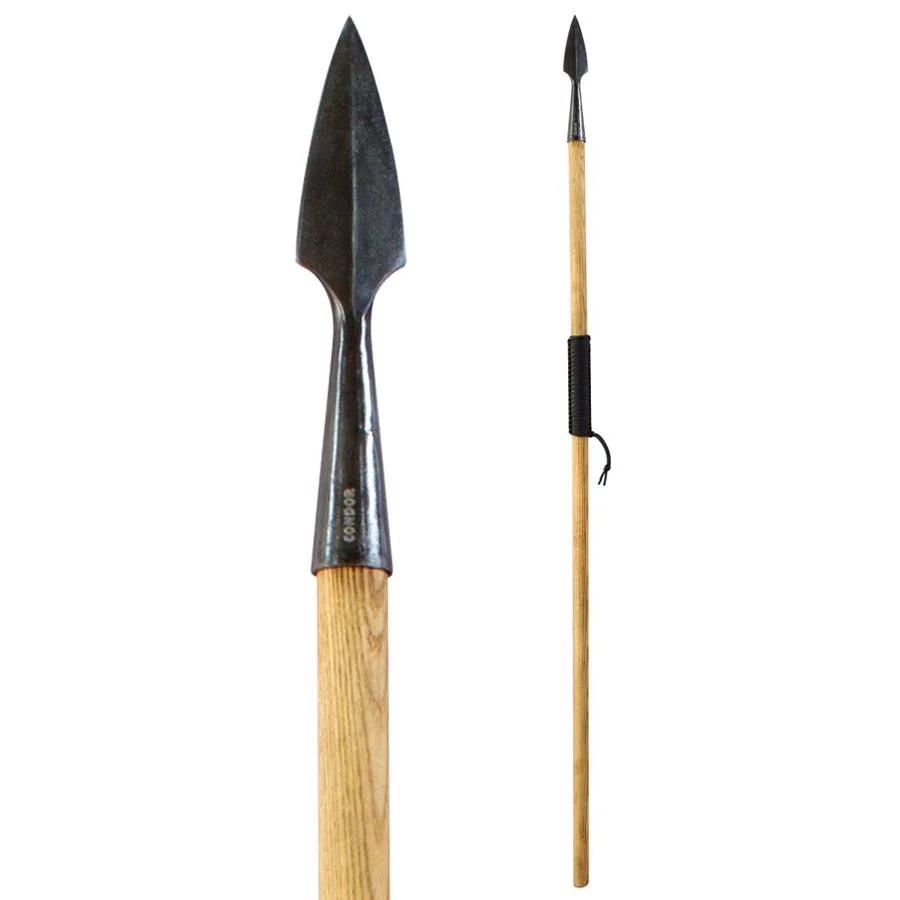
In general terms, the shaft is a long, straight bar that can come in various lengths depending on its design and purpose. Its structure not only provides stability and balance but also allows for greater control of the weapon in combat or during its throwing. The top of the shaft is equipped with a tip, typically metal, which is specially designed to penetrate the target and cause damage. In many cases, this tip can be interchangeable, allowing the user to adapt the weapon to different modes of use, such as hunting or combat.
Additionally, the shaft may include decorative or functional elements, such as grips or ribbons, which enhance grip and maneuverability. The decoration of the shaft is a significant aspect in many cultures, where the spear is not only a weapon but also a symbol of status and skill.
There are various categories of pole weapons, each designed according to its function, whether in hunting or combat. These weapons, ranging from the spear to other variations such as halberds and pikes, have evolved throughout history, adapting to the needs of warriors and hunters. In many civilizations, pole weapons have shared these two functions, highlighting their versatility and cultural relevance.
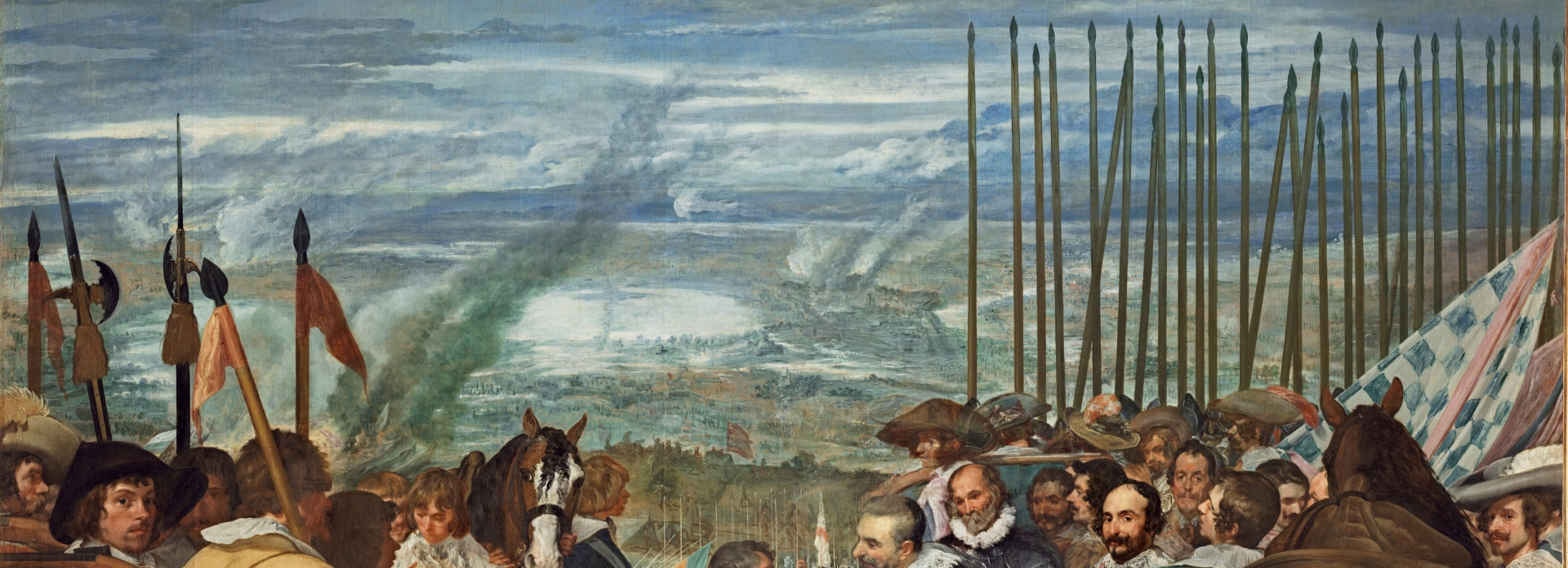
The butt is an essential part of the spear, often overlooked in discussions about weapons, but its role is crucial for the performance and functionality of the weapon. In this article, we will delve into what the butt is, its functions, the materials it is made from, and its historical and cultural importance.
The Butt of the Spear
Located at the opposite end from the tip or point of the spear, the butt has evolved in shape and function over time. Its design and construction may vary depending on its specific use and cultural traditions. Below, we explore its key functions:
Main Functions
- Balance: The butt is fundamental in distributing the weight of the spear. Its design helps counterbalance the mass of the tip, improving handling and accuracy during use, allowing the user to throw more effectively.
- Protection: It acts as a reinforcement at the back end of the shaft, preventing it from splintering or being damaged upon impact with the ground or in combat situations. This prolongs the weapon's lifespan.
- Secondary Use: In situations where the main tip becomes unusable or combat turns into hand-to-hand, the butt can be used as an emergency weapon.
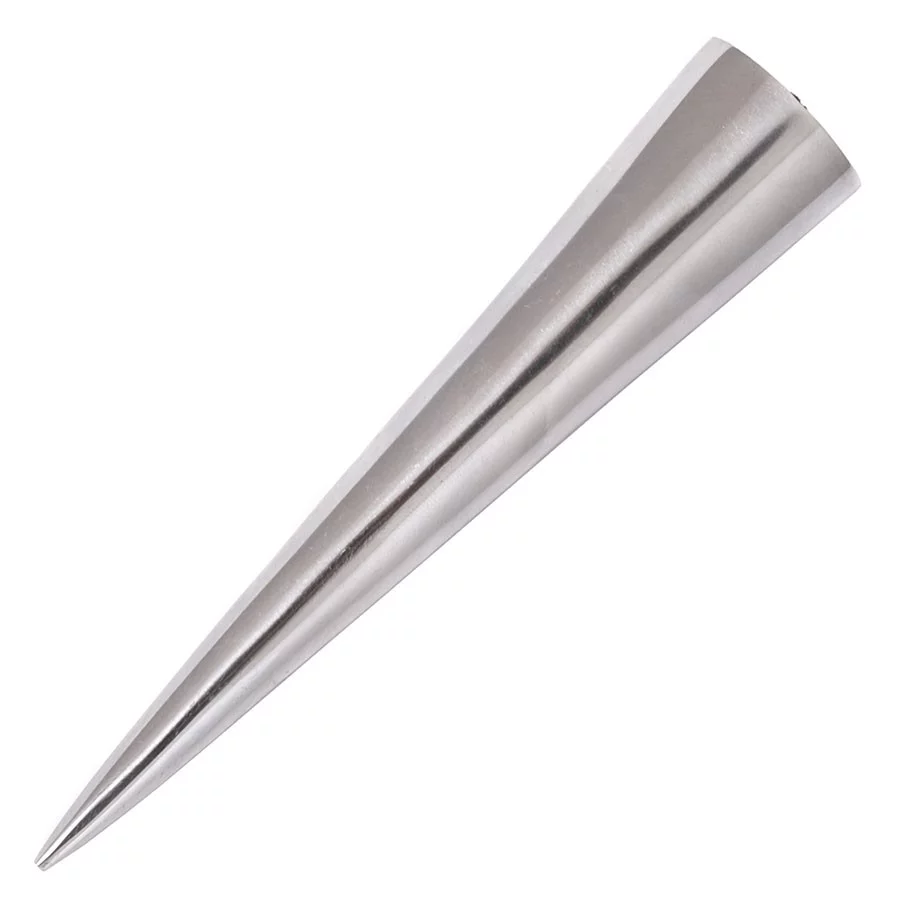
Materials and Design
Butts can be made from a variety of materials, each offering specific characteristics that affect performance and durability:
- Metal: Commonly made of iron or bronze, metal butts are highly durable and add weight that can improve the spear's balance.
- Leather: This material provides good protection without adding much weight, and has been highly valued in various cultures throughout history.
- Hardened Wood: A more economical option that, while less durable, can offer sufficient strength for everyday use spears.
The design of the butt also presents considerable variability:
- Simple Butt: A metal cap covering the end of the shaft; a practical and efficient solution.
- Pointed Butt: Some butts feature a small point, allowing for inverted use of the spear in emergency situations.
- Decorative Butt: On ceremonial or high-status spears, these butts can be adorned with engravings or elaborate designs, reflecting the social status of the bearer.
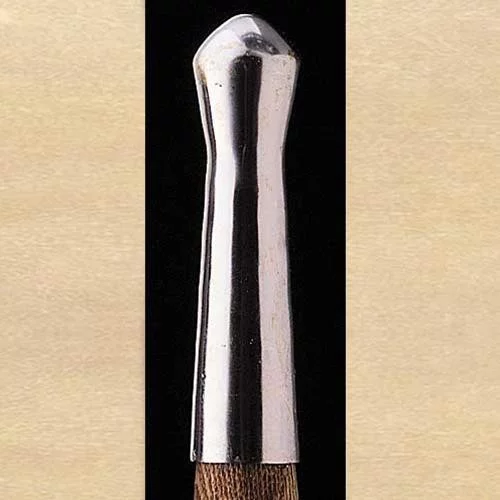
Description of the Spear Butt
The butt is a key piece in the construction and design of spears, providing stability and balance during use. Additionally, it protects the end of the spear from damage incurred during use and storage. Generally, it is made from durable materials like metal or hardwood to withstand both impacts and prolonged wear.
Style and Variety: Butts are not uniform. Their design can vary significantly depending on the time period and culture they come from. Some are functional and simple, while others reflect much about the bearer’s status due to their ornamental details.
Historical Uses: Over the centuries, butts have had various applications, from hunting to warfare, adapting to different contexts and needs. During the Middle Ages, for instance, it was common for spears with butts designed for mounted charge to become popular among knights.
Importance in Military History: Equally significant is the symbolic aspect of the butt; it is a testament to the art of weapon-making. The design and quality of the butt often played a crucial role in the spear’s performance, influencing its flight and penetration ability, essential factors on the battlefield.
The butt, far from being a mere component, is an element that combines functionality and cultural significance, standing out as a testimony to the ingenuity and skill of weapon makers throughout history.
Pole weapons, such as spears, pikes, and halberds, have been an integral part of military history, playing an essential role in both hunting and combat. With origins that can be traced back to ancient times, they have significantly evolved to meet the needs of their users over time. In this article, we will explore the features, uses, and evolution of these weapons, as well as their impact on warfare strategies.
Spears
The spear is one of the oldest and most versatile weapons we know. Its first use was recorded in prehistory, where it served primarily as a hunting tool.
- Structure: The shaft of a spear generally measures between 2 and 4 meters in length, ending in a sharp blade known as a spearhead.
- Types: There are different variants, such as combat spears, intended for direct confrontation, and tournament spears, which are lighter and shorter.
During the conquest of Mexico, both the Spanish conquerors and the indigenous warriors used spears, highlighting the indigenous teputzopilli, made of wood with obsidian points, highly effective in combat.
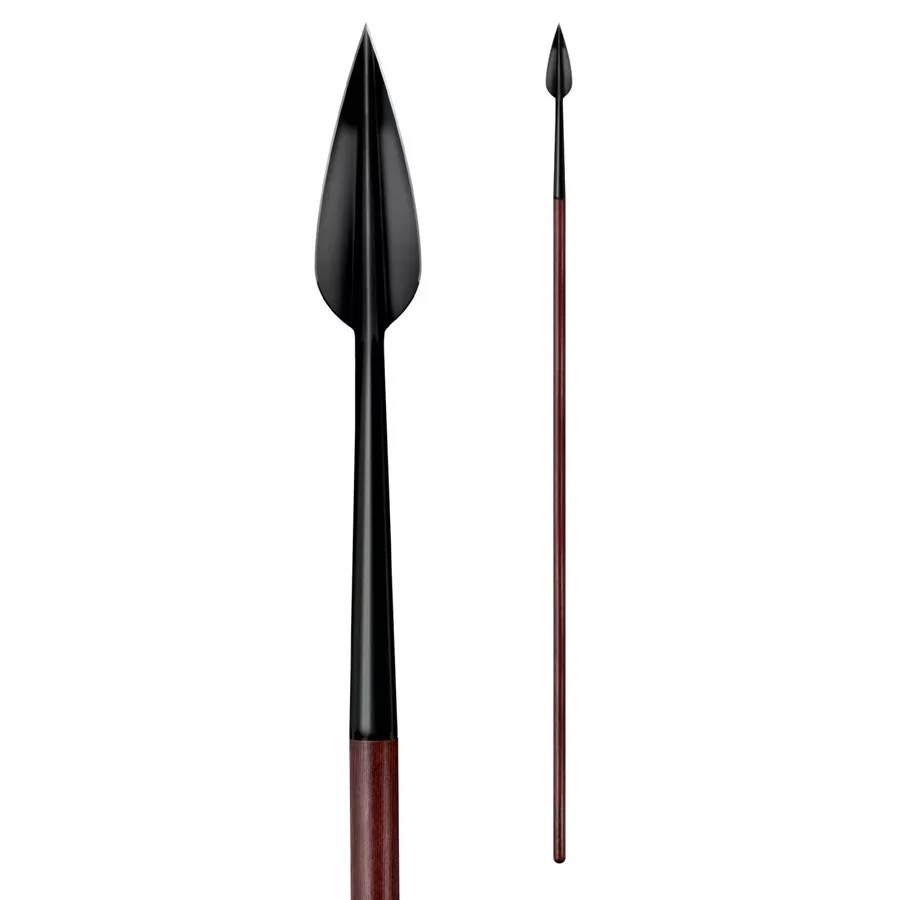
Pikes
The pike is another notable pole weapon, especially recognized for its length and weight, crucial in military formations, such as that of the pikemen.
- Structure: Its shaft is usually longer, commonly made of wood, and ends in a sharp metal tip.
- Tactics: In combat, pikes allow for effective defensive lines against mounted enemies and projectiles. Tactical innovations, such as those introduced by Gonzalo de Córdoba, improved the integration of pikes with arquebusiers on the battlefield.
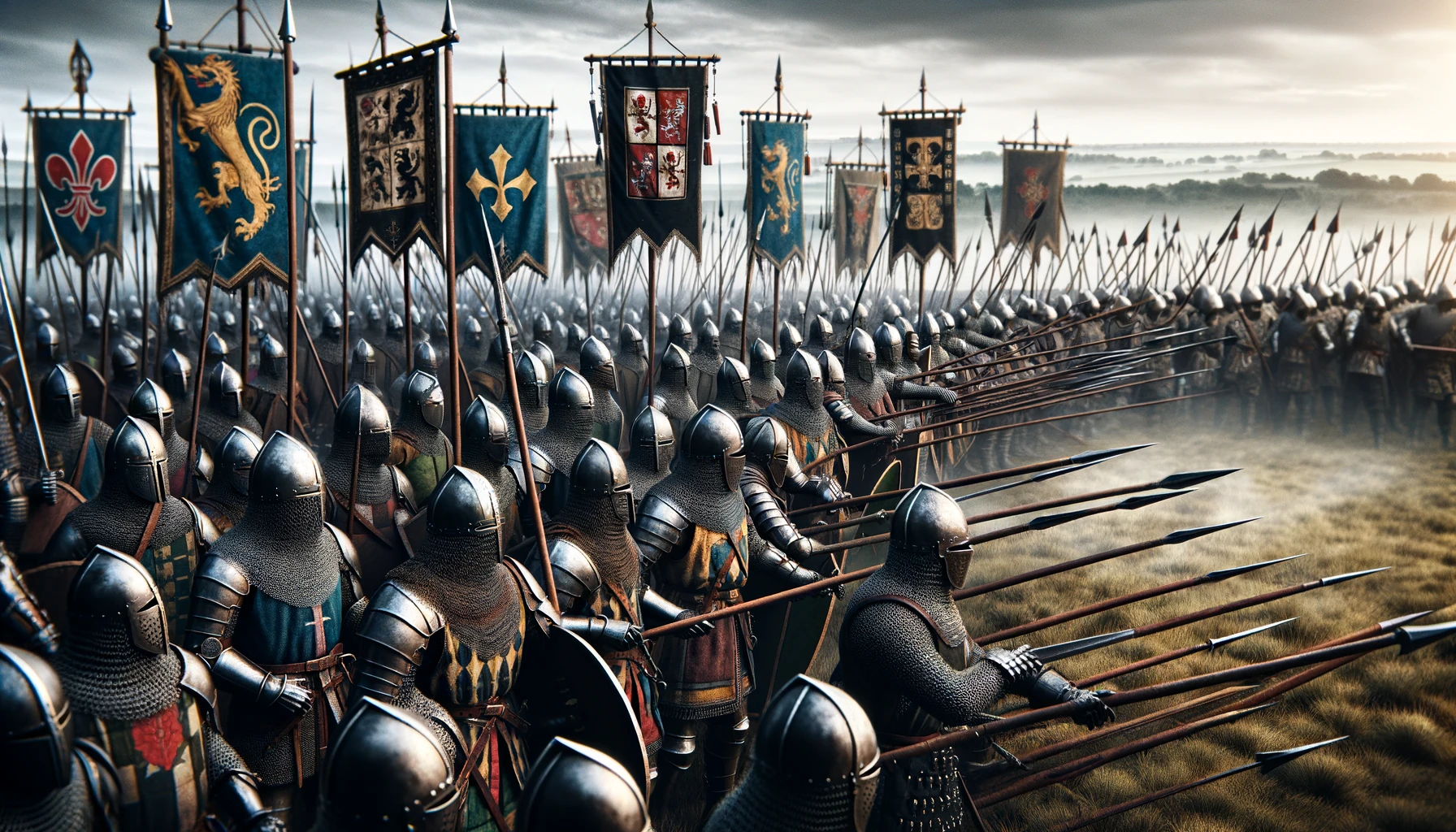
Halberds
The halberd is a versatile combination of a spear and an axe, widely used during the Middle Ages.
- Structure: It features a blade similar to an axe and a sharp point, suitable for different types of attacks.
- Use: It is perfect for close combat, allowing soldiers to disarm horses and mounted opponents.
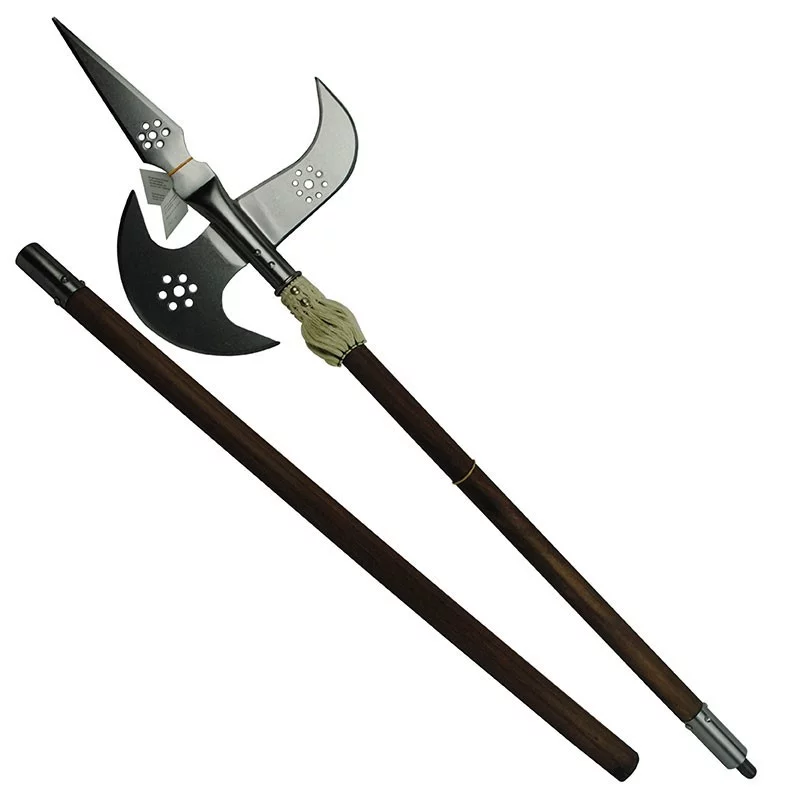
Comparison of Pole Weapons
| Weapon | Length | Weight | Use |
| Spear | 2-4 m | 1-10 kg | Hunting and combat |
| Pike | 3-4 m | 10-20 kg | Pikemen formations |
| Halberd | 1.5-2.5 m | 5-15 kg | Close combat |
Pole weapons, with their diversity and particularities, not only were crucial in the development of military strategies throughout history but also left a profound mark on combat dynamics that endure to this day.
The Yajiri, also known as Yanone, is an arrowhead with a rich history in Japanese military tradition. These arrowheads have captured the attention of historians and enthusiasts for their unique design and functionality in combat. Throughout this article, we will explore the origin, characteristics, and cultural significance of the Yajiri or Yanone in Japan.
Origin and Description
The term 'Yanone' specifically refers to the arrowhead, while 'Yajiri' is a variant of the name. These arrowheads were predominantly used by samurais and are a prominent example of skill and ingenuity in the art of war in Japan.
Features
- The Yajiri or Yanone can measure up to 30.5 cm in length, depending on the specific purpose for which it was designed.
- Made from sturdy and sharp materials, these arrowheads were effective on the battlefield, providing warriors with significant advantages in accuracy and impact.
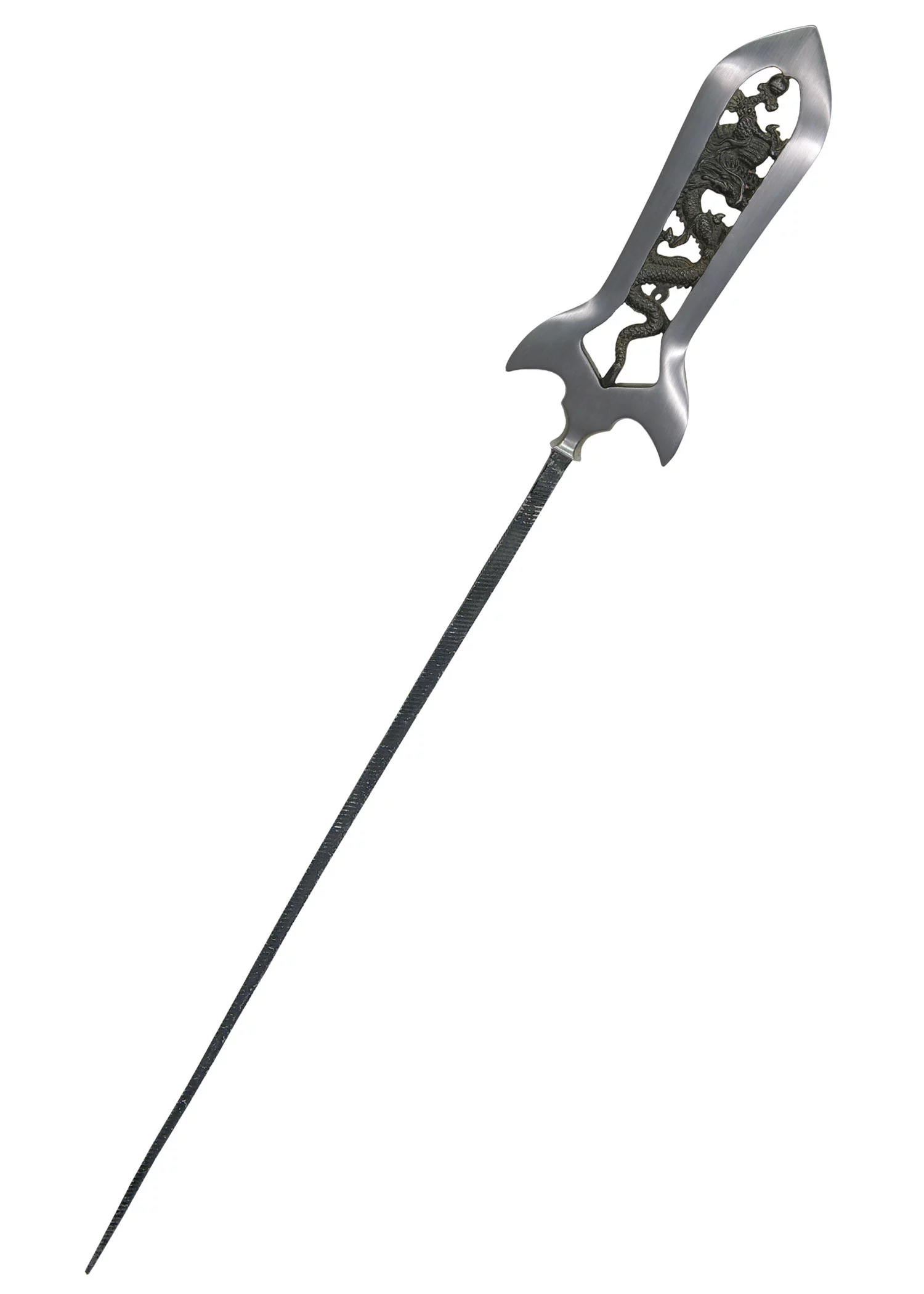
Use in Warfare
The Yajiri or Yanone was essential in the combat strategies of the samurais. It was not only used for long-range attacks but also employed in more elaborate tactics involving various types of shots.
Usage Techniques
- There are various variants of Yanone, each adapted to different types of combat, from field battles to duels.
- Warriors trained hard in its handling, developing techniques that required high precision and skill.
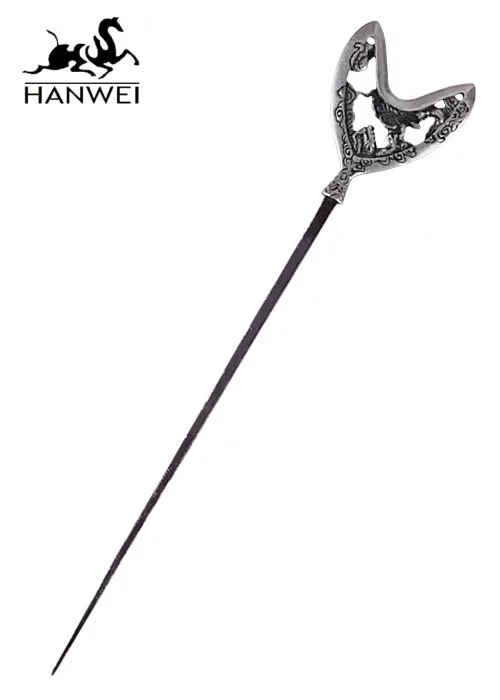
Cultural Relevance
Beyond being mere weapons, arrowheads like the Yajiri or Yanone have become cultural symbols in Japanese history. On many occasions, these arrowheads represent the skill and honor of the samurai warrior.
Legacy
Despite the decline in the use of arrows in favor of modern technologies, the legacy of the Yajiri lives on among collectors and military history enthusiasts. The reproductions and study of these artifacts allow for the preservation and transmission of Japan's rich history.
| Type of Yanone | Length (cm) | Use |
|---|---|---|
| Traditional Yanone | 30.5 | Long-range combat |
| Defensive Yanone | Variable | Personal defense |
| Ceremonial Yanone | Commonly shorter | Rituals and ceremonies |
In the military history of Antiquity, the pilum and the soliferreum stand out as two types of throwing weapons that played a crucial role in combat tactics. While they shared similar purposes, their design and development exhibit notable differences. This detailed analysis explores their characteristics, functions, origins, and their relationship with other contemporary weapons.
Functional Similarities Between the Pilum and the Soliferreum
Both weapons had a clear purpose: to be thrown by the infantry just before close combat. Their primary function was to pierce enemy shields and armor, incapacitating the adversary or compromising their defense. This tactical use made them indispensable elements in the arsenal of the legions and other armies of the period.
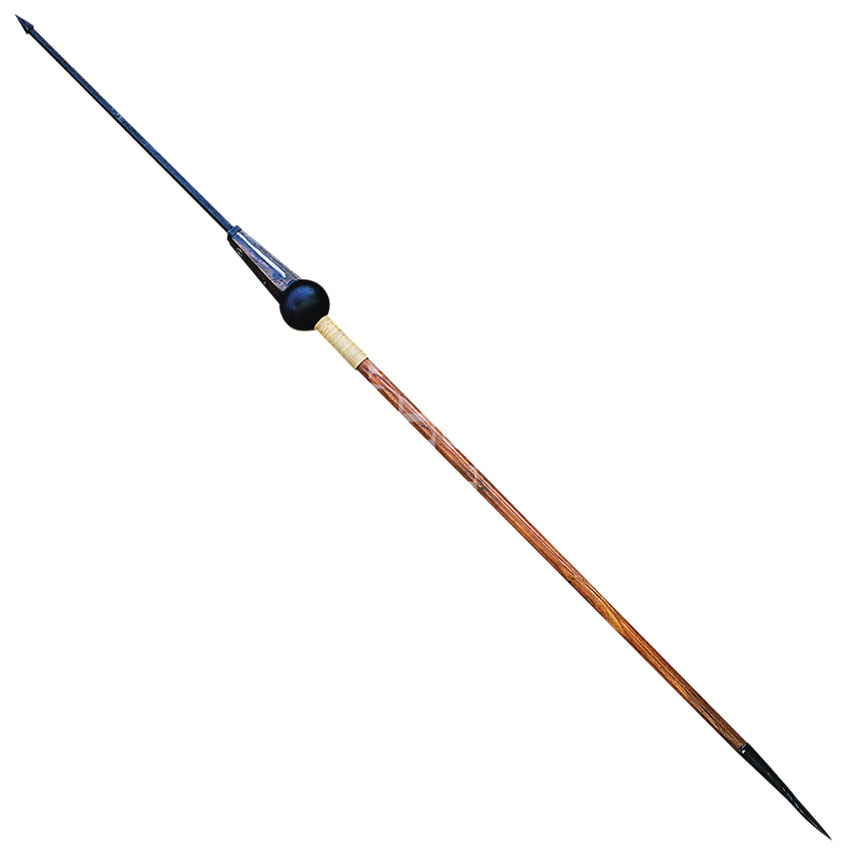
In this sense, the pilum, the soliferreum, and other similar weapons like the falarica played a crucial strategic role. By incapacitating enemy shields, they facilitated a more advantageous close combat for the attacker.
Differences in Construction
Pilum: A Combination of Wood and Iron
- Structure: The pilum combined a relatively short wooden shaft with an elongated iron head that constituted a significant portion of its total length.
- Design: Depending on its era, different systems were used to join the shaft and the head, such as socket fittings or tangs with rivets. This design ensured that, upon impacting a shield, the tip remained embedded, making it difficult to remove.
Soliferreum: Fully Metallic
- Material: Unlike the pilum, the soliferreum was made entirely of iron.
- Shape: Its structure consisted of a circular-section shaft that thickened in the center for easier handling. It could also include moldings or facets to prevent slippage due to sweat.
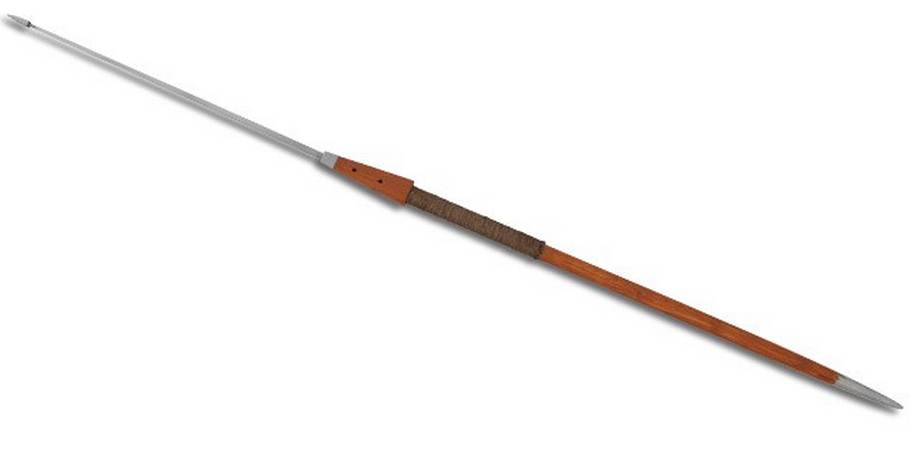
Origin and Development of Both Weapons
The Pilum
The origin of the pilum is subject to debate. Some literary sources point to an Iberian inspiration, while archaeological evidence suggests parallel development in various regions. The oldest types included a socket fitting, which later evolved into the tang with rivets design characteristic of the Romans.
The Soliferreum
The earliest records of the soliferreum date back to the 6th century BCE, primarily in southern France. While some studies suggest that the pilum replaced it, other evidence indicates that both coexisted and evolved independently according to regional needs.
Relationship with Other Weapons
Falarica
The falarica is described in classical sources as a heavy javelin primarily used in the Iberian Peninsula. Its functional similarity to the pilum links it to the framework of throwing weapons of the era.
Gaesum
The gaesum, another term for javelins of various types, was common among Celtic and Iberian peoples. Athenaeus noted that the use of the gaison (a related term) was adopted by the Romans, although its design varied depending on the region and culture.
A Technology of Convergence
The similarity between the pilum, the soliferreum, and other similar weapons in different cultures suggests a phenomenon of technological convergence, where distinct societies independently developed similar weapons due to common tactical needs. This fact highlights how the conditions of combat shaped the military innovations of the time.

General Comparison
| Category | Pilum | Soliferreum |
| Construction | Wood and iron | All iron |
| Origin | Debated (Iberian inspiration) | Southern France, 6th century BCE |
| Use | Thrown to incapacitate shields | Thrown to pierce enemy defenses |
The analysis of these weapons reveals not only their specific roles in ancient warfare but also the diversity of technical responses to the challenges of combat in different cultures.
During the Middle Ages, spears and halberds rose as prominent weapons in warfare. Although they may seem similar as both are pole weapons, they exhibit considerable differences in both design and application in combat. This article delves into these two legendary weapons, unraveling their characteristics, historical developments, and their utility on the battlefield.
Origins and Evolution
Spears
- Origins: With a history that dates back to ancient times, spears were extensively used by civilizations such as the Greek and Roman. They were particularly notable in the formation of the hoplite phalanx, where soldiers protected themselves with large shields and carried long spears.
- Design: Medieval spears typically ranged from 1.8 to 2.4 meters in length, featuring a metal triangular tip. Some designs included elements like wings at the base of the tip, which helped prevent excessive penetration and facilitated recovery during combat.
Halberds
- Origins: They emerged in Europe around the year 1300, influenced by German and Scandinavian military techniques. The halberd became particularly famous in the hands of Swiss mercenaries, who maximized its capabilities in combat.
- Design: A pole weapon approximately two meters long, combining a spear tip at the top with a crossblade similar to an axe, and another piercing element on the opposite side.
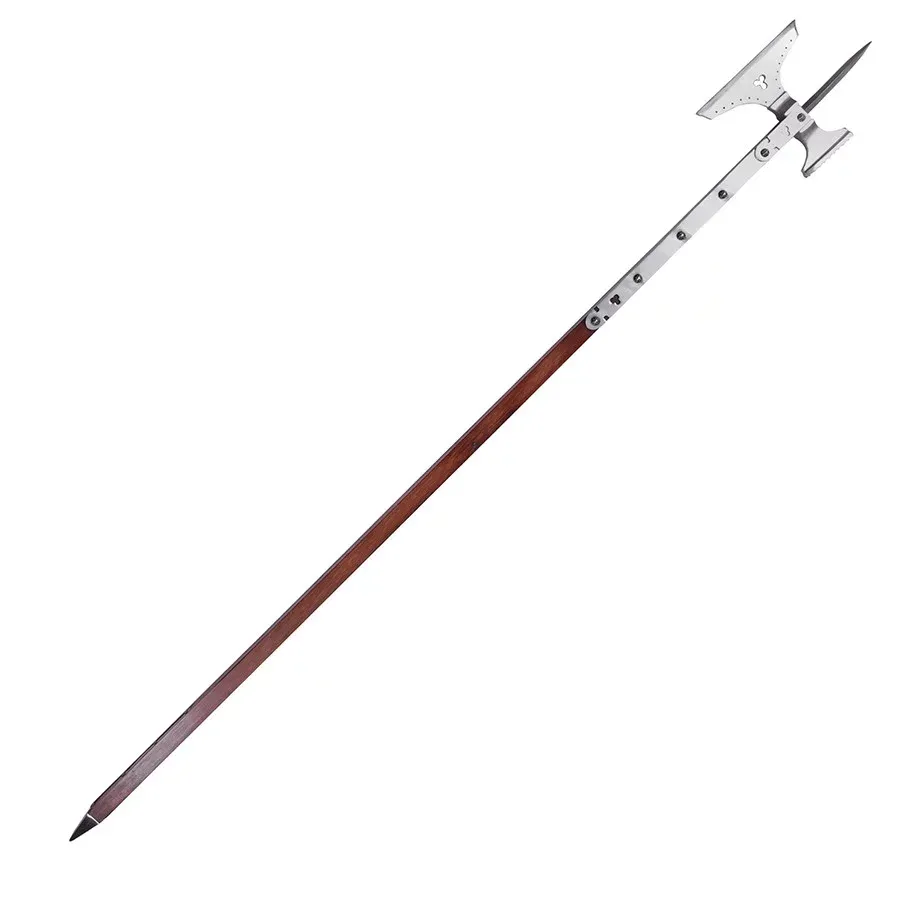
Functionality and Use in Combat
Spears
- Use: Versatile for both ranged and close combat. They could be thrown or wielded to deliver blunt strikes. The "winged spear" was distinguished by its ability to prevent deep penetration due to its wings at the base, facilitating handling during combat.
- Advantages: Their manufacturing was relatively straightforward, requiring little training compared to other weapons. They were useful for both foot infantry and cavalry, allowing the wielder to use a shield simultaneously.
Halberds
- Use: The weapon of choice for close combat. Its multifunctional design allowed for both piercing the enemy and executing aggressive cross cuts.
- Advantages: Effective for taking down mounted enemies, offering the ability to hook and control other weapons, granting great versatility on the battlefield.

Fundamental Differences
- Length and Design: While spears were generally longer and suitable for throwing or ranged attacks, halberds had a more compact design, with offensive features like an additional cutting blade.
- Functionality: The spear excelled in both ranged engagement and close combat, while the halberd specialized in hand-to-hand fighting thanks to its ability to pierce and cut simultaneously.
- Historical Use: While spears have a legacy tied to tactics like the Greek phalanx or Roman infantry, halberds found their peak during the Middle Ages in Europe, gaining popularity among Swiss mercenaries.
Both weapons played essential roles in medieval military tactics. While the spear offered versatility and ease of handling, the halberd provided a powerful impact in close encounters. Today, these weapons are not only subjects of historical study but also representative of the tactical complexity and evolution of military strategies over the centuries.
The javelins are weapons that have existed since prehistoric times, initially used for both hunting and combat. Specifically designed to be thrown, these spears have evolved over time, marking their place in history and modern sports. Below, we will explore in detail the characteristics, types, and uses of the javelin.
Origins and Use in Prehistory
The javelin has origins that date back to prehistoric times. Back then, hunters used it to capture prey, making it a vital weapon in conflicts between primitive tribes as well. The skill of throwing javelins with precision provided a significant advantage by allowing targets to be hit from a distance without exposure. Some cultures even developed straps to retrieve javelins after they were thrown, demonstrating an ingenious adaptation to the needs of warfare and survival.
Types of Javelins
Throughout history, various types of javelins have emerged, each designed with specific characteristics for a particular purpose:
- Harpoon: A javelin with a detachable tip that was originally used in prehistoric times to hunt large animals. Today, the term refers to a iron shaft with barbs, employed for fishing large fish and whales.
- Javelin: A small spear with a robust tip, designed to be thrown with strength and precision using the arm.
- Dart: Lighter than the spear, it was used as a javelin since the Bronze Age, allowing for longer throws.
- Frámea: This javelin had a length similar to that of a man, making it practical for both throwing and close combat use.
- Pilum: Used by Roman soldiers, its ingenious iron tip detached upon impact, rendering the enemy's shield useless by embedding itself.
- Venablo: A short spear, symbol of the Spanish ensign in the 16th century, noted for its versatile handling in combat.
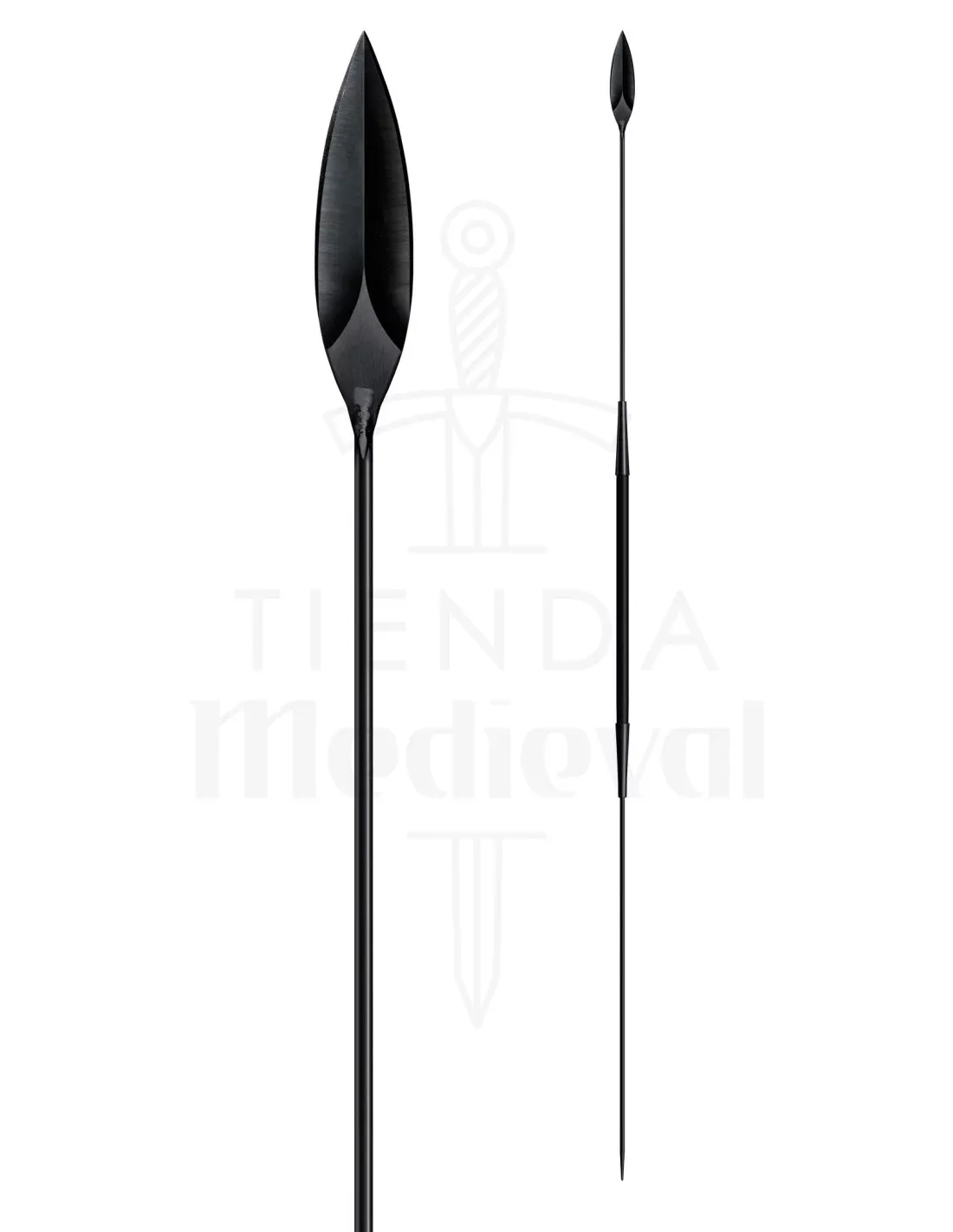
Use in Athletic Competitions
In the modern context, javelins play a prominent role in athletic competitions. The javelin throw event in athletics involves throwing a standard metal or fiberglass javelin as far as possible. This discipline tests the strength, technique, and precision of athletes.
Characteristics of the Javelin for Competitions
The javelins used in competitions possess specific characteristics:
- Length and Weight: The men's javelin measures between 260 and 270 cm and weighs a minimum of 800 g, while the women's javelin measures between 220 and 230 cm and weighs at least 600 g.
- Grip: It features a cord grip of approximately 15 cm at its center of gravity, facilitating handling during the throw.
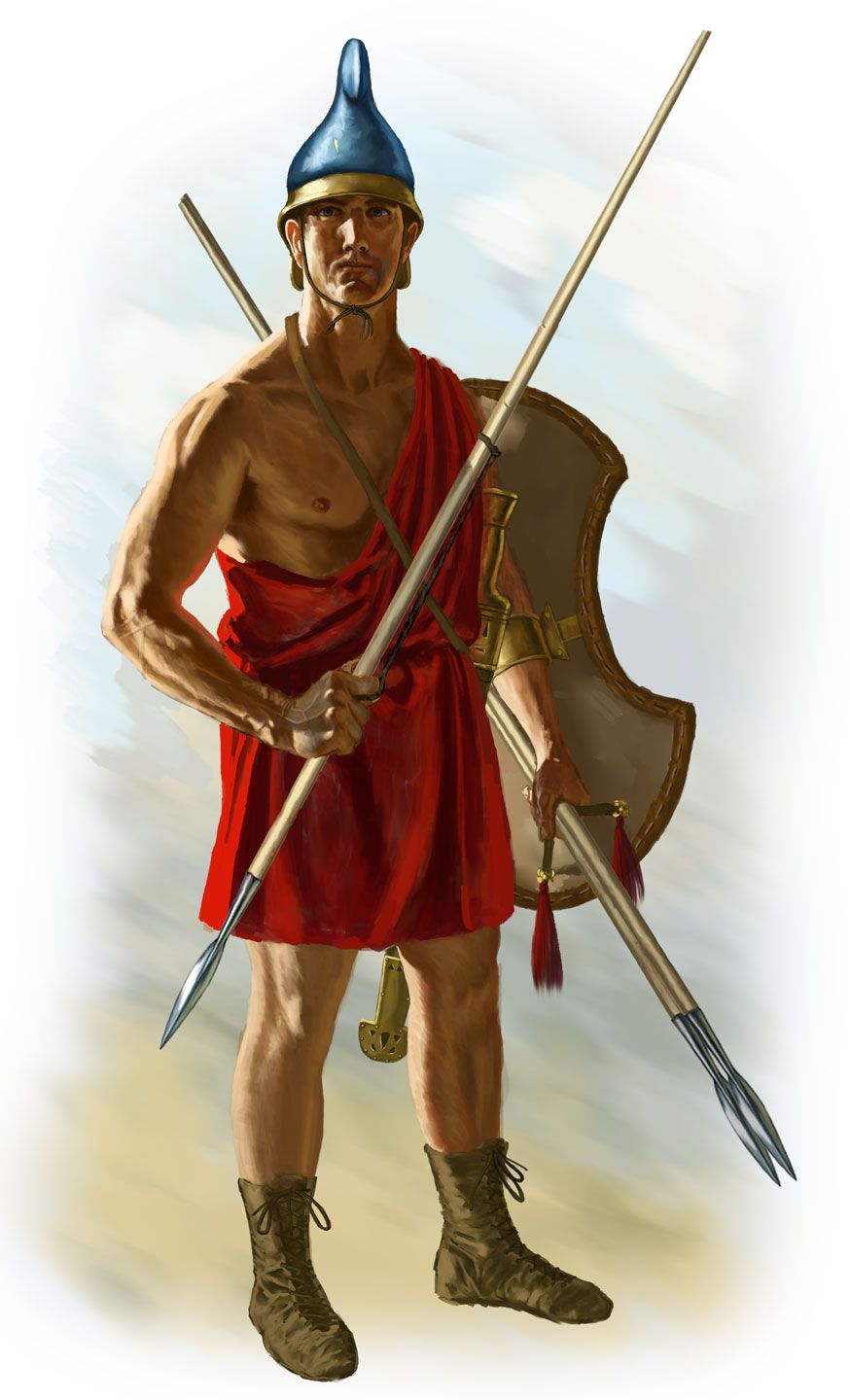
Peltast at English Wikipedia, Public domain, via Wikimedia Commons
Historical Example
The javelin throw has deep historical roots, being one of the disciplines in ancient Greece as part of the pentathlon. This classical competition not only tested the physical and skill-based abilities of athletes but also celebrated their talents in a variety of physical activities, reinforcing the importance of the javelin throw and its cultural value throughout history.
With its rich history and presence in modern sport, the javelin is much more than a simple weapon; it is a symbol of technique, precision, and athletic tradition.
The plumbata, also known as *martiobarbuli*, is a remarkable Roman military invention from the 3rd century AD. It represents a strategic advancement in the combat tactics of the Roman infantry and is distinguished by its ingenious design and effectiveness on the battlefield. It is often regarded as significantly important due to certain mentions by Vegetius, a well-known Roman military writer, who advocates for its intensive use.
.webp)
Structure and Design of the Plumbata
The plumbata dart is characterized by several design features that made it extremely efficient:- Metal Tip: It featured a metal tip, often perforated, which favored stability during flight and improved its penetration capability.
- Lead Core: At its center, a lead core provided the necessary mass and stability for an effective throw, enhancing its lethality.
- Extension and Grip: The extension at the tail of the dart allowed legionaries to hold it firmly, facilitating an accurate throw.
- Length: Plumbatas ranged from 30 to 45 cm long, providing a stable trajectory and increased precision.
Strategic Use in Combat
The plumbata was an essential tool in Roman military tactics:- Throwing: It was common for legionaries to throw the plumbata from low positions with a vertical motion, reaching enemies at distances of up to 80 meters.
- Effectiveness in Varied Terrains: Its use excelled in arid or wooded environments, effectively disrupting enemy formations, and even in siege defenses, where its impact was amplified when thrown from elevated positions.
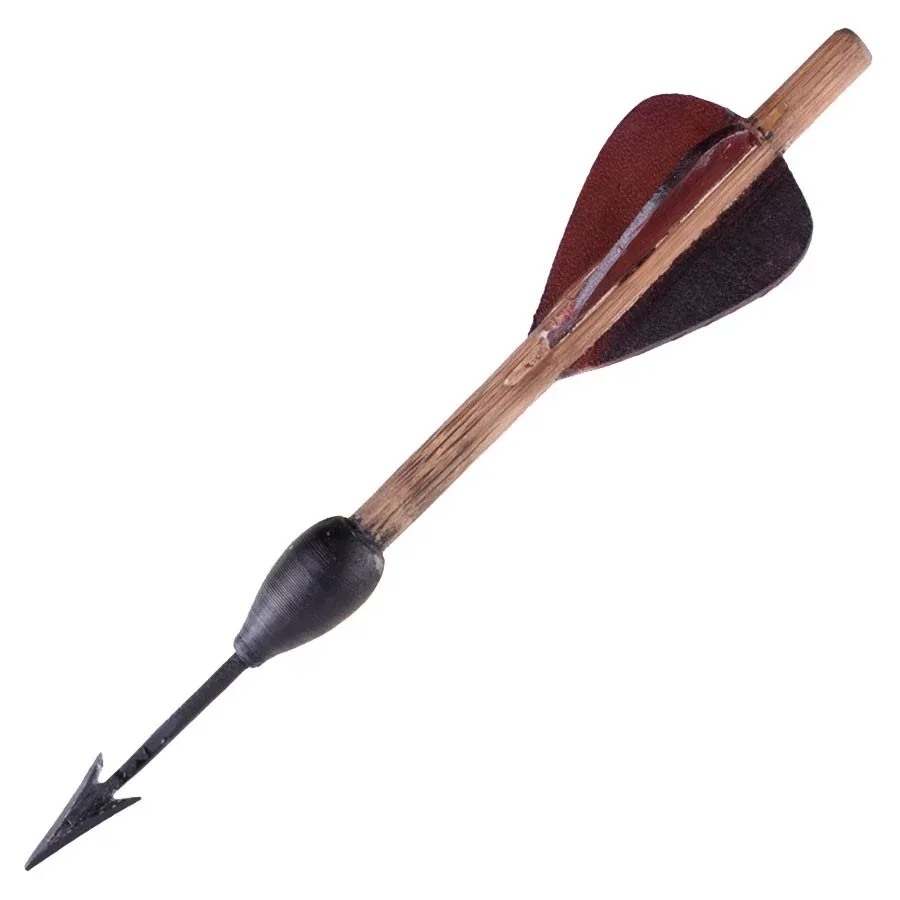
Historical Legacy
The impact of the plumbata on military history is confirmed by various sources:- Vegetius and His Influence: In his writings, Vegetius emphasizes the necessity of using the plumbata as an integral part of the infantry.
- Mention in the Strategikon: This military manual, edited under Emperor Maurice in the 6th century AD, underscores its prolonged tactical relevance.
Debate and Representations
Despite anecdotal evidence, the representation of the plumbata in contexts such as naval battles remains uncertain. Interestingly, some imperial coins may include images of these weapons, reflecting recognition and respect for their use in the legions.| Component | Description |
|---|---|
| Tip | Metallic and perforated for stability and penetration |
| Core | Lead weight for increased mass and stability |
| Grip | Extension for a firm hold and precise throw |
| Length | Variable, between 30 and 45 cm |
The plumbata represents an innovative advancement in the evolution of infantry weapons in antiquity. Its sophisticated design and effectiveness in combat demonstrate why this weighted dart remained in use for centuries, becoming a cornerstone of Roman military strategy.
The term "roquete" may seem enigmatic due to its varied meanings and historical applications. Throughout the centuries, it has played fundamental roles in both religious and military contexts. In this article, we will break down the different interpretations of "roquete," from its function in ecclesiastical attire to its use in medieval tournaments.
Roquete in the Religious Context
In the religious realm, specifically within the Roman Catholic Church, a roquete is an ecclesiastical garment made of linen, similar to an alb but shorter and not fitted to the body. It resembles a chasuble, although it features narrow sleeves that reach the wrists. This garment has been used since the 13th century by bishops and some canons, and it has remained a hierarchical symbol following the liturgical reforms of the Second Vatican Council.
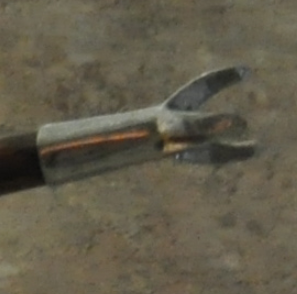
The roquete, not being considered merely an ornament, acts as an indicator of clerical jurisdiction. In ceremonies, prelates wear it with the choir habit or as a substitute for the chasuble in liturgical events where the alb is unnecessary.
Roquete in the Context of Lances
In the medieval context, the "roquete" also refers to the metal tip of certain lances used in jousts and tournaments. Designed to catch on the opponent's armor, the roquete was intended to unseat the knight from his horse.
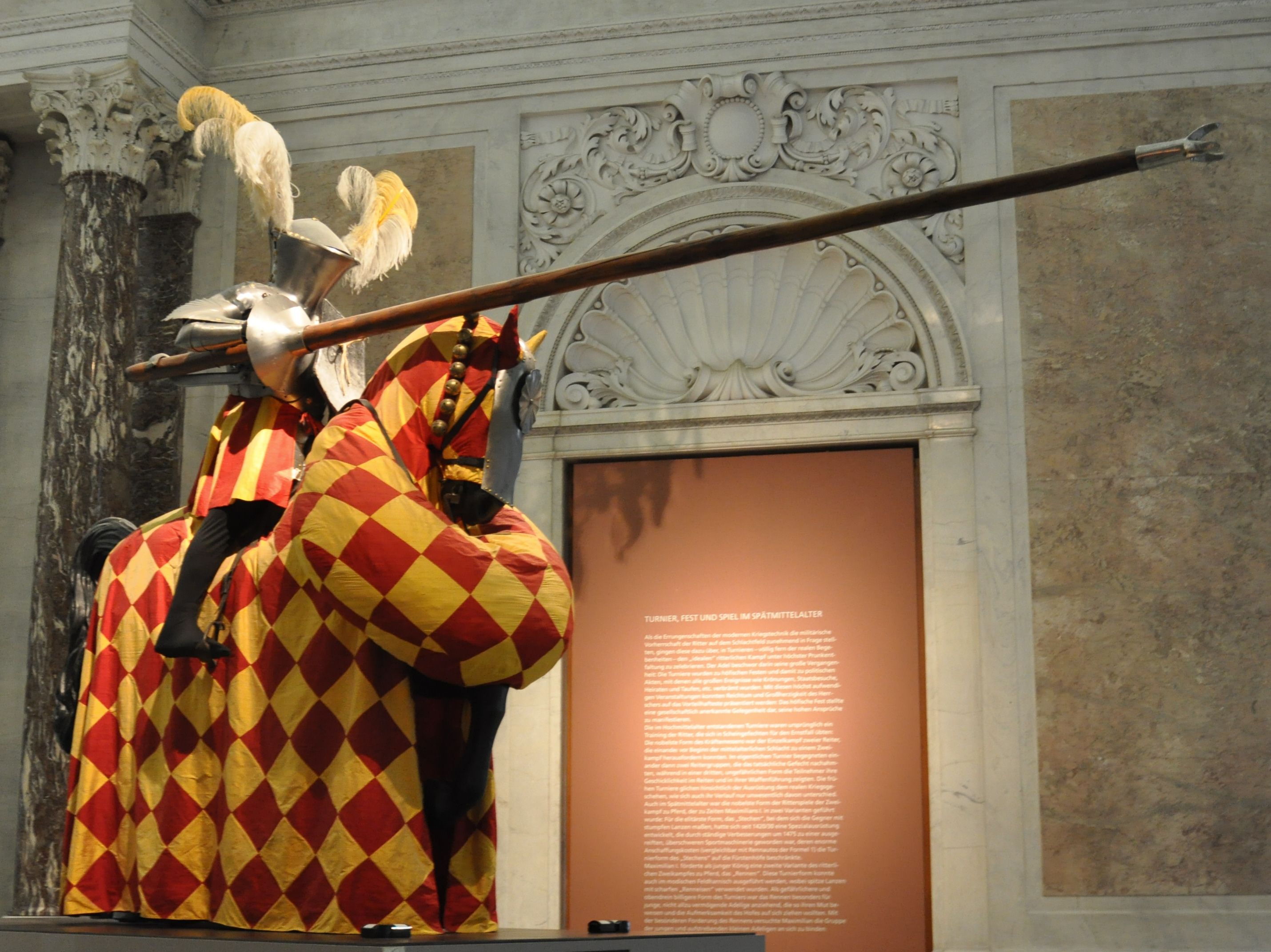
Photo: Andreas Praefcke, Public domain
This lance component typically had three or four points, with different shapes. The most common ones in the 15th century were those with small and blunt tips or thick and separated ones. This clever design allowed it to hook onto enemy armor to destabilize the rider.
Roquetes in the Medieval Context
The expression "roquetes" also appears in medieval records referring to garments, as evidenced in inventories from the time. An example is the inventory from Huesca in 1565, which describes "the gray habit with four roquetes." This usage indicates that, much like in the religious context, the term could relate to outfits.
The usage of the word "roquete" surprisingly varies from garments to military equipment, providing a rich perspective on its meanings throughout history. The plurality of meanings underscores the intersection of religion, warfare, and the everyday in medieval times.
















